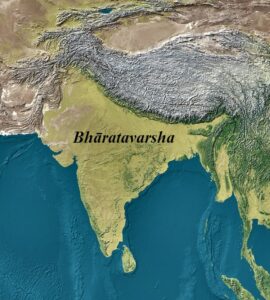Both. India has always had two names, and they’re both equally important, in different ways.
The subcontinent to the east of the river Indus (derived from the name Sindhu in Sanskrit) was always known to those outside as Hindu (Persian), Indikē (Greek), India (Latin), and so on, and recognized to be a distinct civilization. It is by these names, based on the river Indus, that people around the world have known us for millennia.
What is Bhārat?
Bhārat is India’s identity of itself.
The Rig Veda is a set of 1028 ancient hymns and poems composed over the course of many millennia. Sometime around 1500 B.C., as per modern historians, the poems were compiled together in ten volumes (called Mandalas) and carefully preserved. This is the form in which they have come down to us. Several poems in the Rig Veda describe a furious battle called the Battle of the Ten Kings. Historians agree that this battle was an actual historical event.
As per the poems, a confederation of 10+ clans ganged up and attacked the Bhārata clan, but after prolonged fighting, the Bhāratas were successful in defeating them and driving them out of their lands. The battle was fought, at different times, on the banks of River Yamunā and River Rāvi, which flow through modern India’s Uttar Pradesh, Haryana, Delhi, and Punjab states. Based on modern and historical place names, many of the defeated clans appear to have migrated and settled in areas to the west of the Indus.
The Bhāratas expanded their territory in the Indian subcontinent and eventually became a powerful superstate, winning the loyalty of and receiving taxes from all the surrounding kingdoms in return for protection. We don’t know the exact geographical extent of the ancient Bhārata empire, but we do know that their legacy has extended and endured far beyond their empire.
One of the reasons for this may be the Mahābhārata.
Itihāsa – Meaningful History
Among the various types of ancient Indian literature is a genre called Itihāsa. Itihāsa in Sanskrit literally means “thus indeed it was,” and is defined in the ancient texts as “history told in an entertaining style with moral teachings.” In other words, historical fiction for the purpose of religious instruction. The two most important Itihāsa works are the Rāmāyana and the Mahābhārata, the latter of which was inspired by the history of the Bhārata clan.
The introduction to the Mahābhārata says that its composer, Sage Vyāsa, having studied the Vedas, Upanishads, Purānas, and all other relevant works, wanted to summarize the contents therein for the benefit and edification of the common man. The result of his endeavors was an epic poem about 15 times the length of the Bible.
The Mahābhārata is told primarily as the saga of the Bhārata clan, which began with King Bharat. His descendants are called Bhārata. A short summary is that decades of strife and bickering among cousins culminate in a great war to preserve dharma (righteousness), and despite having a much smaller army, the righteous side wins, and dharma prevails.
But the Mahābhārata is much more than a story of good over evil. It is a microcosm of life itself. The story has a vast canvas of thousands of characters (2,736 as per one estimate), each with their own storyline and character arc, and each episode is meaningful, memorable, and eminently tellable. You can find parallels in the Mahābhārata for almost any real-life situation that can be found in society even today. You also find out how different responses to the same situation pan out in the end, which is where the “moral instruction” aspect comes in. All in all, then, the Mahābhārata is a lesson in history, life, and morality all rolled into one, and it has shaped the collective consciousness of Indians ever since its composition sometime in the first millennium B.C.
A Civilization Called Bhārat
The first millennium B.C. was an exciting time in the Indian subcontinent. A vast network of highways crisscrossed the entire subcontinent, and traders, pilgrims, bards, minstrels, teachers, students, religious scholars, and others traveled its length and breadth along these highways, exchanging stories and ideas with fellow travelers. This resulted in two things. One was a great flowering of ideas. Various disciplines including linguistics, sciences, mathematics, astronomy, statecraft, and medicine flourished, as did philosophy, literature, and the arts. This is the context in which the six schools of Hindu thought as well as Buddhism and Jainism evolved.
The other result was that ideas from every part of the subcontinent spread across all of it, giving the entire subcontinent a shared culture, a shared system of values, and a shared memory of history.
The Vishnu Purāna (a 1st millennium B.C. work) says:
उत्तरं यत्समुद्रस्य हिमाद्रेश्चैव दक्षिणम् ।
वर्षं तद् भारतं नाम भारती यत्र संततिः ।।
That which is north of the ocean and south of the Himadri
Is the varsha called Bhārata, where dwell the Bhārati
[Himadri – the Greater Himalayas, i.e., the highest range of the Himalayas; varsha – a division of land separated by mountain ranges (varsha means rain, and the Indian subcontinent is geographically defined by the monsoons, which happen when the clouds from the ocean hit the Himalayan peaks); Bhārati – descendants of the Bhāratas]

Modern Politics vs. Ancient Civilization
India as a state with its current borders is a recent political entity. In the past, many empires, dynasties, and kingdoms, big and small, have ruled different parts of the subcontinent.
But whether it was the Mauryas, Guptas, Cholas, Kushans, Ahoms, or anyone else, they were all children of Bhāratavarsha – the land north of the ocean and south of the snowy peaks.
This is what the name Bhārat brings with it – a sense of belonging to a civilization, a civilization to which every part of India has contributed, and to which every part of India has a right.
Leave a Reply